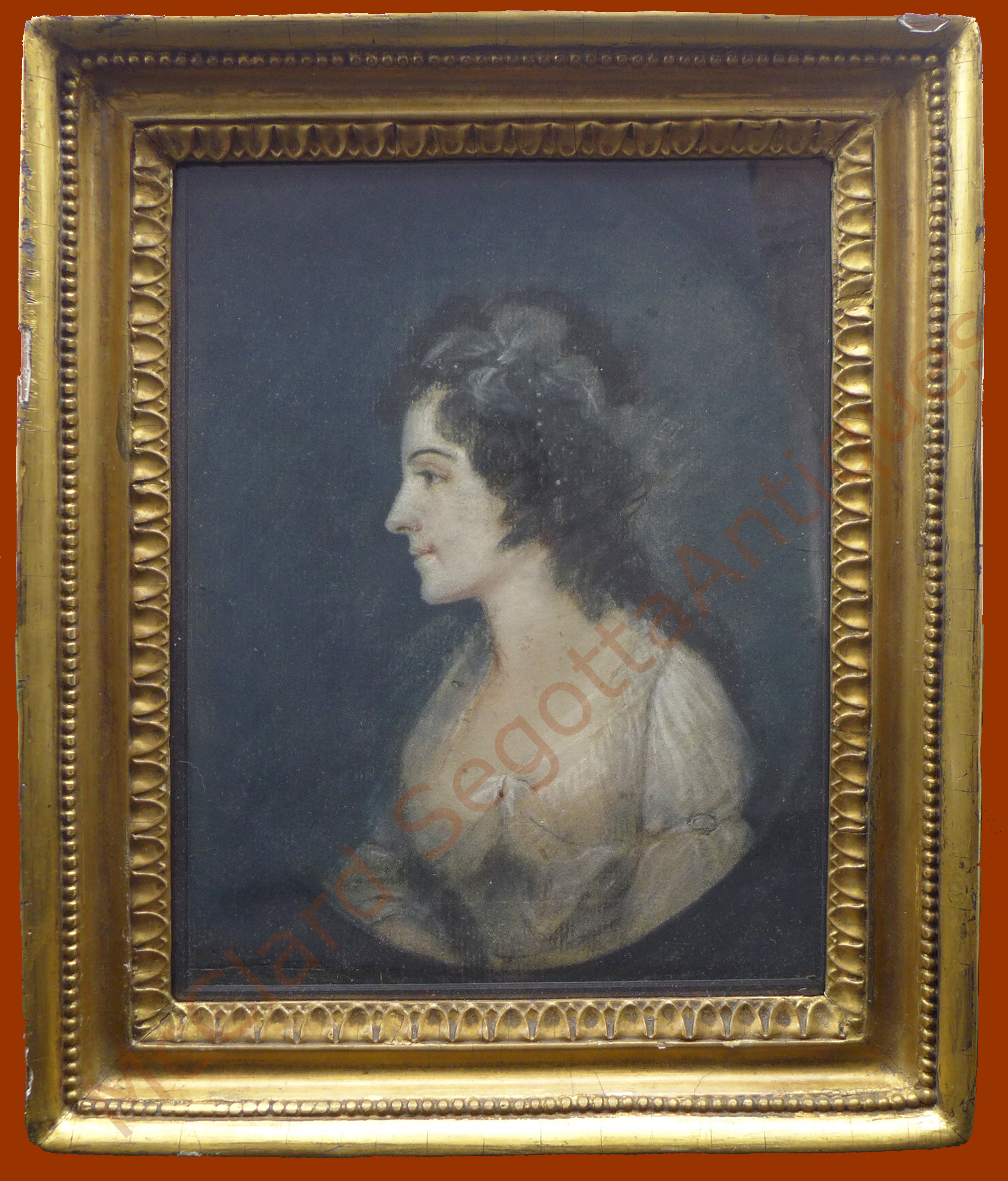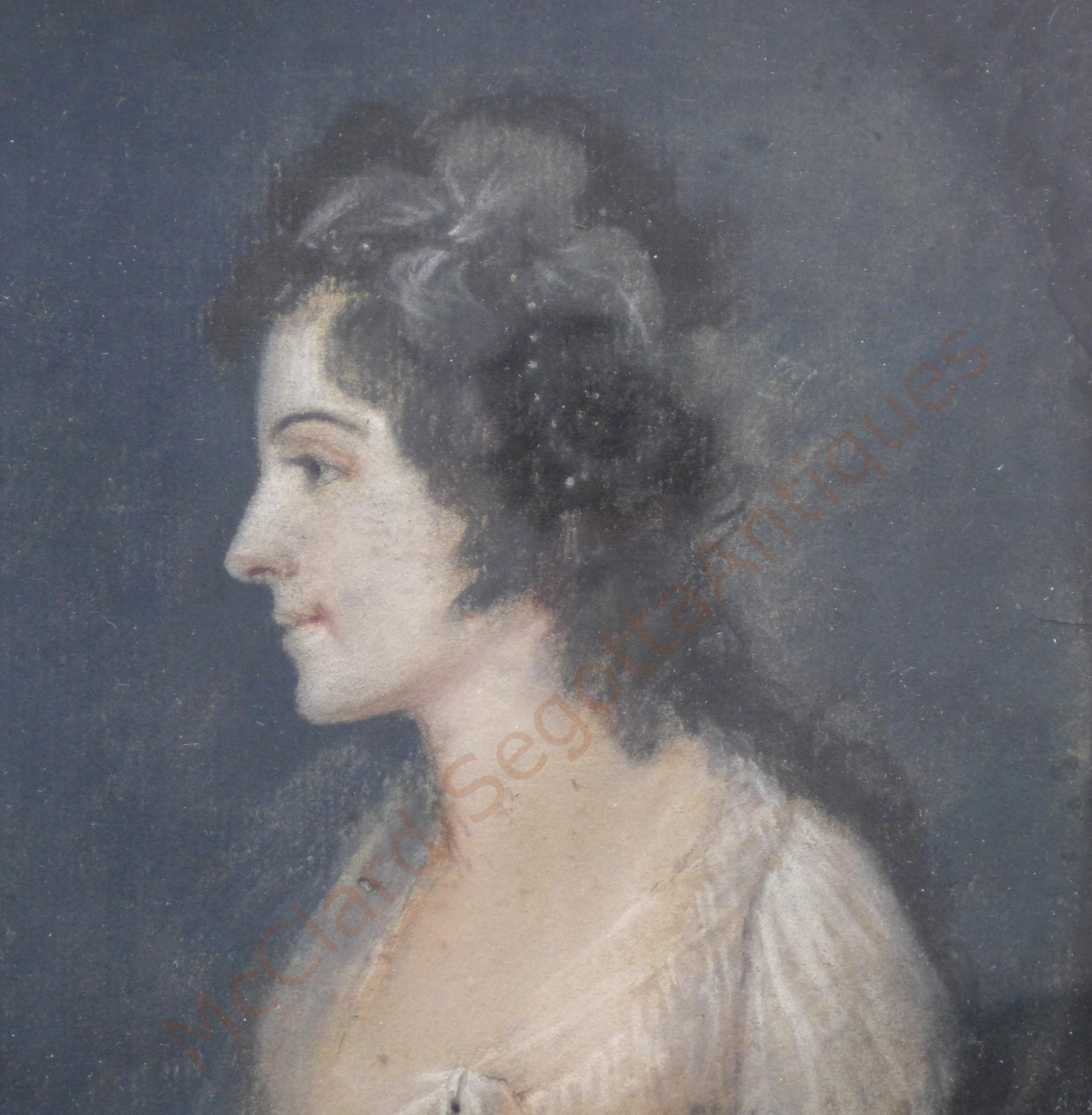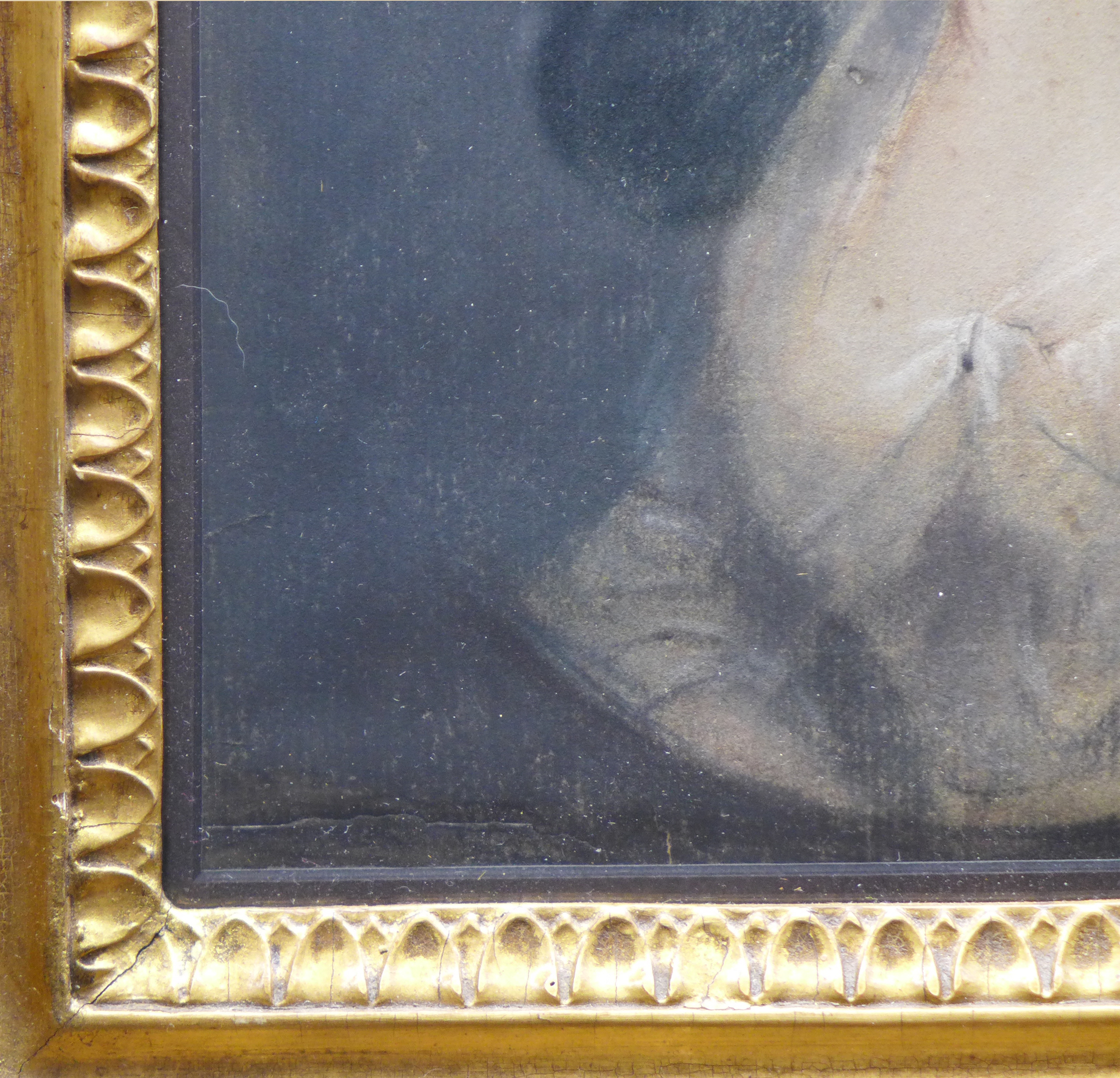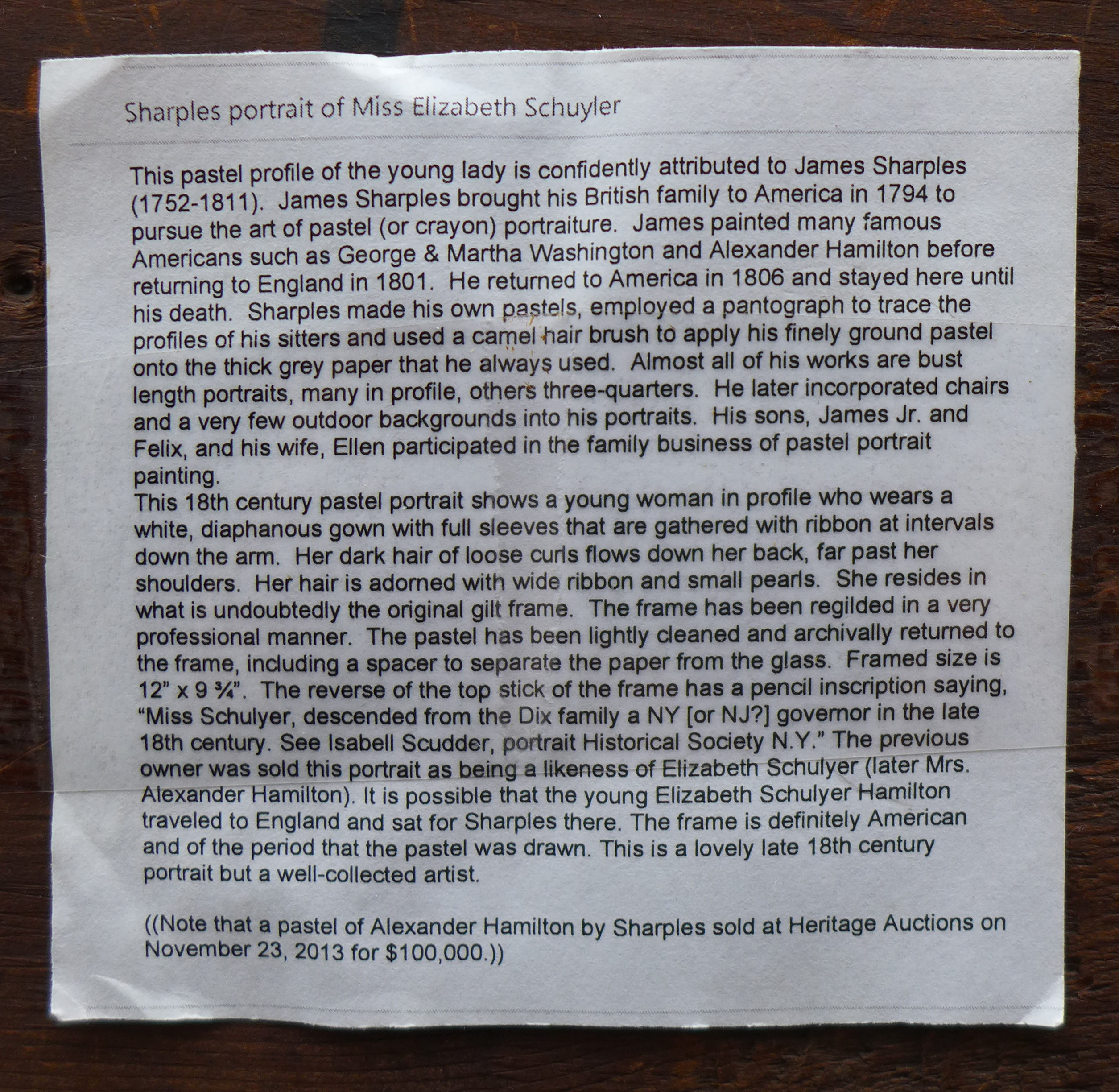
This crayon (the period word for pastel) drawing is of Elizabeth Schuyler Hamilton on laid paper and is attributed to James Sharples. Sharples brought his family to America in 1794 and drew portraits of many of our nation's forefathers and foremothers. He was indeed important in chronicling our history. Alexander Hamilton sat for Sharples in 1796 and it is surmised that Eliza sat for him that same year. She would have been 39 years old. Since the style of wearing powdered wigs had past, this is the first portrait showing her natural hair which makes her look younger than the previously painted portrait by Ralph Earl--interestingly she sat for Earl while he was imprisoned. This Sharples portrait is one of only two that she is known to have sat for while she was married to Hamilton. If you search the internet for Elizabeth Schuyler Hamilton, you will see this portrait and the large portrait by Earl on many pages. This is one of the portraits that defines Eliza for the current day.
James Sharples was an established portraitist in England before he moved his family to America in 1796. Almost immediately on his arrival his small and miniature portraits became popular with the Revolutionary War Era public. Sharples third wife, Ellen, two of sons, James Jr. and Felix, and daughter, Rolinda were all artists who worked creating commissioned copies of James’ work as well as drawing portraits of their own creation. Sharples and his family drew pastel portraits of an impressive list of American fore-parents including George (in two poses) and Martha Washington, John and Abigail Adams, Thomas Jefferson, the Hamiltons, and even Alexander Hamilton’s nemesis (and killer) Aaron Burr. The list of important Revolutionary War Era American portraits by the Sharples family is long and impressive.
Elizabeth Schuyler was married to Alexander Hamilton in 1780. In the short 24 years in which the couple was married, she bore him 8 children. She grew up with wealth as her father was Revolutionary War General Philip Schuyler and her mother Catherine Van Rensselaer were from some of the wealthiest of Dutch immigrants in New York and New Jersey (both part of New Netherland, the first Dutch colony of North America). She fell in love with Alexander Hamilton when he was aide-de-camp to General George Washington. Her parents blessed Eliza’s marriage to Hamilton despite the facts that he was not of Dutch descent, his social stature was much different than the high stature of the Schuyler family and that, financially, he was a near pauper. Eliza remained in love and married to Hamilton until his death at the age of 49 in a duel with former Vice President of the United States, Aaron Burr. Eliza remained at his side despite the fact that he publicly admitted having an extramarital affair and that he spent more money than he made, leaving Eliza and their seven children with much debt but no money. The elegant home, The Grange, that she and Alexander had designed and built was sold at public auction to pay debts. The executors of Hamilton’s estate sold The Grange back to Eliza at half price so that she could continue to raise their children there. At the age of 76 Eliza resold The Grange and bought a townhouse in New York where she lived with two of her grown children.
During their marriage, Eliza supported poor women and children with both money and time. After Hamilton’s death (when she first learned that her husband had left her penniless), Eliza continued that support those in need as a founding member of Society for the Relief of Poor Widows with Small Children and Orphan Asylum Society. She worked for those groups for 42 years, raising funds, collecting needed goods, and overseeing the care and education of over 700 children. Eliza died in 1846 at the age of 97. Hamilton predeceased Eliza by 50 years. She wore mourning clothes for all those 50 years and never remarried.
Condition is very good with what might be a repaired tear in the lower left edge. The portrait is conservation mounted and, considering the delicate nature of pastel, we have not and will not remove it from the frame. Because of the nature of pastel, which never dries and can always be moved around, blacklighting would not show touch-ups so we cannot guarantee that there have not been any. If there are touch-ups, we cannot see evidence of them. The frame is a beautiful Federal period (possibly original) frame with carved and decorated coves. The outer-most convex cove has a string of beading and then there is a nice, unadorned scoop or concave cove. The inner-most edge of the frame is ornamented with a gouge-carved design that reminds us of tulips. There are some chips to the gilding at the outside edge that we show in the photos. The frame was nicely regilded at some point before the chipping—it was probably done at the same time that the painting was conservation mounting. It is a very professional water-gilding. Framed size is 10” x 12” with a sight size of 7 ½” x 9 ½”.
Don’t miss the chance to own the beautiful and important piece of American history. Circa 1796.
#7091 Sold
Jaffares, Neal, Dictionary of pastellists before 1800 online edition, http://www.pastellists.com/Articles/Sharples1.pdf
New Netherlands Institute, Elizabeth Schuyler Hamilton [1757-1854], Notable Dutch-Americans, https://www.newnetherlandinstitute.org/history-and-heritage/dutch_americans/elizabeth-schuyler-hamilton/.
Presnell, Jenny L., American National Biography, Elizabeth Schuyler Hamilton, https://exhibitions.nysm.nysed.gov//albany/bios/s/elschuyleranb.html.
Scott, Susan Holloway, A Charming Profile Portrait of Eliza Hamilton, c1796, https://susanhollowayscott.com/blog/2018/12/3/a-charming-profile-portrait-of-eliza-hamilton-c1796.




